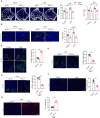This is a preprint.
Mechanical loading-induced change of bone homeostasis is mediated by PGE2-driven hypothalamic interoception
- PMID: 37790467
- PMCID: PMC10543368
- DOI: 10.21203/rs.3.rs-3325498/v1
Mechanical loading-induced change of bone homeostasis is mediated by PGE2-driven hypothalamic interoception
Update in
-
Brain regulates weight bearing bone through PGE2 skeletal interoception: implication of ankle osteoarthritis and pain.Bone Res. 2024 Mar 5;12(1):16. doi: 10.1038/s41413-024-00316-w. Bone Res. 2024. PMID: 38443372 Free PMC article.
Abstract
Bone is a mechanosensitive tissue and undergoes constant remodeling to adapt to the mechanical loading environment. However, it is unclear whether the signals of bone cells in response to mechanical stress are processed and interpreted in the brain. In this study, we found that the hypothalamus of the brain regulates bone remodeling and structure by perceiving bone PGE2 concentration in response to mechanical loading. Bone PGE2 levels are in proportion to their weight bearing. When weight bearing changes in the tail-suspension mice, the PGE2 concentrations in bones change in line with their weight bearing changes. Deletion of Cox2 or Pge2 in the osteoblast lineage cells or knockout Ep4 in sensory nerve blunts bone formation in response to mechanical loading. And sensory denervation also significantly reduces mechanical load-induced bone formation. Moreover, mechanical loading induces CREB phosphorylation in the hypothalamic ARC region to inhibit sympathetic TH expression in the PVN for osteogenesis. Finally, we show that elevated PGE2 is associated with ankle osteoarthritis (AOA) and pain. Together, our data demonstrate that in response to mechanical loading, skeletal interoception occurs in the form of hypothalamic processing of PGE2-driven peripheral signaling to maintain physiologic bone homeostasis, while chronically elevated PGE2 can be sensed as pain during AOA and implication of potential treatment.
Conflict of interest statement
Competing Interests No completing interests.
Figures







References
-
- Doherty AH, Ghalambor CK, and Donahue SW. Evolutionary physiology of bone: bone metabolism in changing environments. Physiology (Bethesda). 2015;30(1):17–29. - PubMed
-
- Samelson EJ, Broe KE, Xu H, Yang L, Boyd S, Biver E, et al. Cortical and trabecular bone microarchitecture as an independent predictor of incident fracture risk in older women and men in the Bone Microarchitecture International Consortium (BoMIC): a prospective study. Lancet Diabetes Endocrinol. 2019;7(1):34–43. - PMC - PubMed
Publication types
Grants and funding
LinkOut - more resources
Full Text Sources
Research Materials

